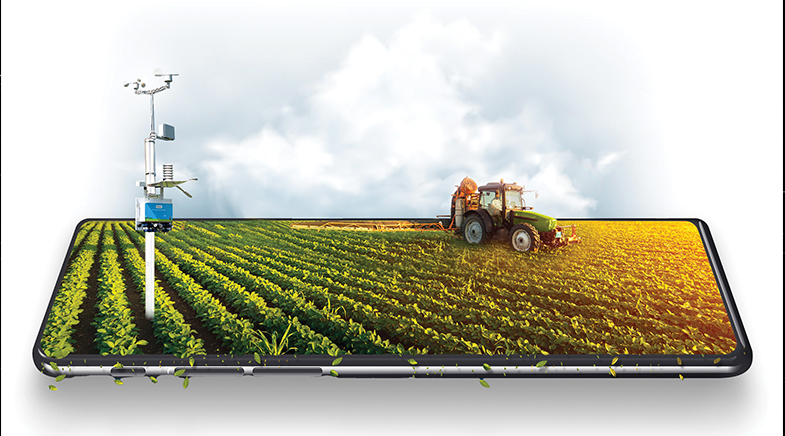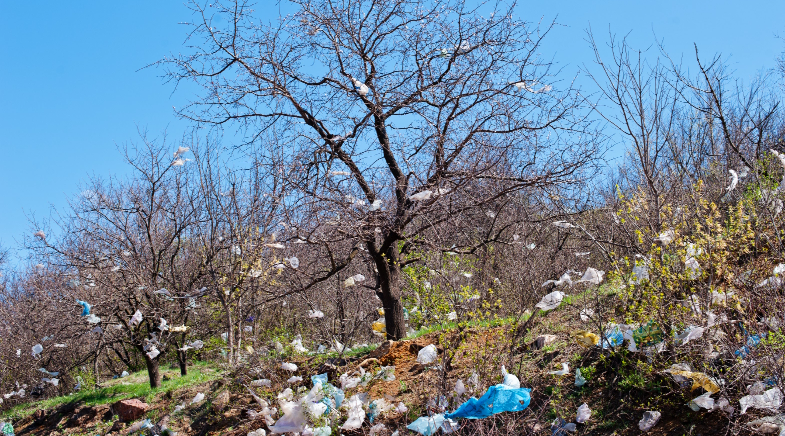Mission insects
-
- from Shaastra :: vol 03 issue 10 :: Nov 2024

Insects keep our planet running. There is an urgency to stem their decline but it will take science and technology to work in tandem.
Insects, the most diverse group of animals on Earth, play crucial roles in maintaining ecological balance and supporting human well-being. While often perceived as pests or disease vectors, insects are essential for pollination and nutrient cycling, and as a food source for other animals. To fully appreciate their significance and value to our planet's future, we need a comprehensive understanding of insect biology, ecology and evolution. This needs to be broader and deeper than our current global and national approaches.
Insects have coexisted with humans for millennia, often in complex relationships that range from beneficial to detrimental. While some insects are indeed vectors of diseases or are agricultural pests, many others provide invaluable ecosystem services. Pollination is perhaps the most well-known beneficial role of insects. Bees, butterflies and moths are crucial pollinators for many crops and wild plants. About 75% of global crops depend on animal pollination, with insects being the primary pollinators. This service is not only ecologically vital but also economically significant, with insect pollination contributing an estimated $235-577 billion annually to global agricultural production. Insects also play a critical role in nutrient cycling and decomposition. Dung beetles, for example, are essential in breaking down animal waste, improving soil fertility and reducing greenhouse gas emissions from cattle farming. Termites, often viewed as pests, are crucial decomposers in many ecosystems, particularly in tropical forests, where they contribute significantly to carbon and nitrogen cycling. Many insects serve as natural pest control agents. Ladybugs, lacewings and parasitoid wasps help control aphid populations in agricultural settings, reducing the need for chemical pesticides. This natural pest control service provided by insects is estimated to be worth several billion dollars each year.
A monthly column that explores themes on nature, nurture and neighbourhood in the shaping of form and function.
THE WEB OF LIFE
The evolutionary history of insects is intrinsically linked with that of plants and other animals, resulting in complex ecological relationships. The relationship between insects and plants is one of the most significant coevolutionary partnerships in nature. As pollinators, many insects have evolved specialised structures to collect and transfer pollen efficiently. For instance, bees have developed pollen baskets on their hind legs, while some moths and butterflies have an elongated proboscis to reach nectar in deep flowers. Conversely, many insects have evolved as plant pests, developing mechanisms to overcome plant defences and animal predators. For example, some caterpillars have evolved the ability to sequester toxic compounds from their host plants, making themselves unpalatable to predators. This evolutionary arms race has led to the development of diverse plant defence mechanisms and insect adaptations. Insects form complex relationships with various animals. They serve as a primary food source for many species, including birds, bats and small mammals. For instance, bats consume vast quantities of insects nightly and control insect populations. However, some insects have also evolved as parasites or disease vectors for animals, including humans. Mosquitoes, for example, have co-evolved with malaria parasites, becoming efficient vectors of this disease.

Historically, insects have been incredibly abundant and diverse, with estimates suggesting there are around 5.5 million species globally. However, recent studies indicate alarming declines in insect populations worldwide. A 2019 global review found that over 40% of insect species are threatened with extinction. The study reported that Lepidoptera, Hymenoptera and dung beetles are among the most affected groups. Another study in Germany found a more than 75% decline in flying insect biomass over 27 years in protected areas. The causes of these declines are multifaceted and often interconnected. Habitat loss due to agricultural intensification and urbanisation is a primary driver. Pesticide use, particularly of neonicotinoids, has been linked to declines in bee and butterfly populations.
Climate change is altering insect distribution and phenology, potentially leading to mismatches with their host plant or prey. As temperatures rise, many insect species are shifting their ranges poleward or to higher elevations. This shift can have cascading effects on ecosystems and agriculture. For agriculture, these shifts can mean new pest pressures in regions previously unaffected. For instance, the coffee berry borer, a major coffee pest, is expected to become a threat in areas where coffee is grown as temperatures rise. Conversely, some regions may lose important pollinators as they move to more suitable climates.
In natural ecosystems, changes in insect distributions can disrupt long-established interactions. For example, as some butterflies move northward faster than their host plants, they may face a lack of suitable habitat. This mismatch could lead to local extinctions and altered community structures.
SCIENCE TO THE RESCUE
Given the critical roles insects play and the threats they face, there is an urgent need for a comprehensive, global insect research mission, and India can and should lead this. This mission should encompass multiple key components. A national, and global, insect survey of urban landscapes as well as biodiversity hotspots is needed. A systematic survey of insect diversity and distribution across different ecosystems is crucial. This survey should be compared with historical records, museum specimens and fossil records to understand how insect populations have changed over time. Such a survey would provide invaluable baseline data and information on past trends for future conservation efforts.
To fully appreciate the significance of insects to our planet's future, we need a comprehensive understanding of their biology, ecology and evolution.
In-depth ecological studies are also needed. Research programmes focusing on the ecology and behaviour of various insect groups in their native context are essential. This should include studies on ants, beetles, moths, bees, wasps and termites, among others. Understanding their life cycles, interactions with other species, and responses to environmental changes are crucial for predicting and mitigating the impacts of global change. Detailed studies on how climate change affects insect physiology, behaviour and distribution are needed. This research should aim to predict future changes and develop strategies to mitigate negative impacts on agriculture and ecosystems.
Based on the data collected, we can develop and implement targeted conservation strategies for threatened insect species and their habitats. Research on how changes in insect populations affect crop pollination and pest control will help develop sustainable management strategies. Initiatives to increase public awareness about the importance of insects and to engage citizen scientists in data collection and conservation efforts are also required.
Such a research mission presents an excellent opportunity for collaboration between top research institutes, universities and citizen scientists. From the Eastern Himalayas to the Western Ghats, India's diverse ecosystems offer a unique laboratory for such studies. Similar initiatives could be implemented globally, creating a network of insect research hubs.
TAPPING INTO TECH
A data centre would be invaluable for the proposed insect research mission. Such a facility would serve as a repository for the vast amount of data generated by surveys, ecological studies and citizen science initiatives across India. This data centre could employ advanced data management systems and artificial intelligence algorithms to process and analyse the collected information efficiently. By integrating diverse datasets – including species distribution, genetic information, behavioural observations and environmental parameters – researchers could uncover patterns and trends that might otherwise remain hidden. The data centre could also facilitate collaboration between different research groups by providing a platform for data sharing and joint analysis. Furthermore, it could serve as a resource for policymakers, offering evidence-based insights for conservation strategies and agricultural policies. By standardising data collection and storage, this facility would ensure the long-term preservation of valuable scientific information and enable longitudinal studies tracking insect populations and behaviours over extended periods.
Pesticides, particularly neonicotinoids, have been linked to declines in bee and butterfly populations.
Remote sensing technologies, including drones and satellite imagery, offer powerful tools for studying insect-plant interactions and monitoring large-scale insect movements. These technologies can provide high-resolution, real-time data on vegetation health, which can be indicative of insect activity. For instance, multispectral imaging can detect changes in plant chlorophyll content or canopy structure that may result from insect herbivory or pollination activities. This information can help researchers map the impact of insects on plant communities across large areas and over time. In the case of locust migrations, remote sensing has proven particularly valuable. Satellite data can be used to identify environmental conditions conducive to locust breeding and movement, such as areas of recent rainfall in desert regions. Drones equipped with thermal cameras can detect locust swarms, allowing for early warning systems and targeted control measures. By integrating remote sensing data with ground-based observations and predictive models, researchers can develop more effective strategies for managing both beneficial and pest insect populations.

India is fortunate to have a strong foundation of insect research through institutions like the Indian Council of Agricultural Research (ICAR) and various State agricultural universities. These organisations have made significant contributions to our understanding of agricultural entomology and pest management. However, to address the complex challenges facing insect populations and to fully leverage their ecological and economic potential, we need to broaden our approach. A more integrative mission would bring together experts from diverse fields such as ecology, genetics, climate science and data analytics. It would also involve collaboration with international research institutions, creating a global network of insect studies. This broader mission could expand the focus beyond agricultural contexts to include urban environments, forests and other ecosystems. By integrating traditional agricultural research with cutting-edge technologies and ecological approaches, we can develop a more comprehensive understanding of insect biology and its implications for ecosystem health and human well-being. This integrated approach would not only enhance our scientific knowledge but also inform more holistic policies for biodiversity conservation and sustainable agriculture.
There is also a wealth of fundamental research that will be of great value to an insect mission. The extensive research on the fruit fly, Drosophila melanogaster, provides an excellent base of genetics, cell biology and neuroscience. Indian research using this organism is of high quality and widespread. Recent reports have decoded the entire connectivity of nerve cells in the fruit fly and linked this to their cell biology and behaviour. These studies have profound value for the study of other insects. Similar in-depth studies on other insect species will provide valuable insights into ecology, evolution and conservation biology. For instance, studies on honeybees have already revealed complex social behaviours and communication systems. Expanding such research to other insect groups could uncover new biological principles and potentially inspire biomimetic technologies. These too must be undertaken as a national effort.
Insects are fundamental to the functioning of ecosystems and human well-being. As we face unprecedented global changes, understanding and conserving insect diversity is more critical than ever. A comprehensive, global insect research mission, led by India, would not only advance our scientific knowledge but also provide the foundation for evidence-based conservation and management strategies.
Such a mission presents an opportunity for cutting-edge, impactful science that could engage researchers at all levels, from undergraduate students to seasoned scientists. By investing in insect research, we invest in the future of our planet's ecosystems and our own survival. The time to act is now, before we lose more of these tiny but mighty creatures that keep our world running.
ALSO READ
Sanchez-Bayo, F., & Wyckhuys, K.A.G. Worldwide decline of the entomofauna: A review of its drivers. Biol. Conserv., 232, 8-27 (2019). bit.ly/affected-insects
Hallmann, C.A., Sorg, M., Jongejans, E., Siepel, H., Hofland, N., Schwan, H., et al. More than 75 percent decline over 27 years in total flying insect biomass in protected areas. PLoS ONE, 12(10), e0185809 (2017). bit.ly/insect-declines
Use citizen science to turbocharge big-data projects. Nature, 634, 7 (2024). go.nature.com/3YKL3X7
Have a
story idea?
Tell us.
Do you have a recent research paper or an idea for a science/technology-themed article that you'd like to tell us about?
GET IN TOUCH















